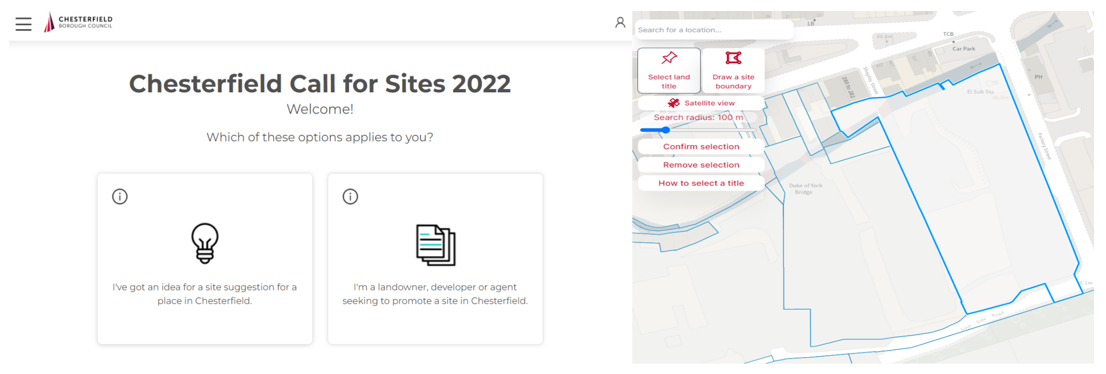Back to Digital Planning Programme Case Studies
Chesterfield Borough Council partnered with Urban Intelligence to develop a digital service to engage a broader range of the community in its ‘call for sites’ consultation, as part of their Regulation 18 Local Plan review.
This included the use of digital technology to facilitate a new route for the community to suggest sites and land uses that could be brought forward for development, and a bespoke site submission route for landowners and developers.

Goals
Chesterfield’s goals were to:
- create a more efficient and automated land availability assessment and call for sites process
- bring in a wider range of contributions – ‘historically, the traditional call for sites was dominated by agents and involved relatively complex forms and we wanted to encourage a broader range of people to respond, who had ideas and suggestions,’ says Antony Wallace (Principal Planning Officer)
- broaden the scope of site assessments to include uses beyond residential and employment land (for example, community uses and biodiversity opportunity sites)
Effective approaches
‘PropTech has clear benefits for call for sites processes – it provides a transparent way of mapping and assessing sites across the district. This has shown us what’s possible, what the solution might be – we can be directly involved in innovation.’ Alan Morey, Planning Manager, Chesterfield Borough Council
Making submissions digital
Traditionally, the council’s local plan was only available by downloading a 27MB PDF, sized at A0, and submissions had to be sent by letter or email. On the new website, members of the public could interact more easily, zooming into detail using interactive maps. For the public, making site suggestions was simplified using tick boxes, free text boxes, with information buttons, prompts to add comments and uploading of photo or video responses. Developers and landowners could make more formal submissions via an online form, in comparison to the previous need to download and fill in a form in Word and submit to the council. The form had validations, so it would only accept appropriate responses.
The council’s communications team, in collaboration with Urban Intelligence, created assets like YouTube videos and articles, which, together with information pop-ups, helped to draw people’s attention to the call for sites and guide participants through processes.
Automating site analysis
Working with the software’s ‘Placemaker’ tool allowed officers to assess suggested sites’ suitability more easily. Previously it could take months to find, map, assess and record the sites manually – now more constraints, policy and site data was gathered in one place and the tool could automatically test how constrained a site was using layers of overlapping data including assessing against policies like flood risk to quickly identify sites without high levels of constraints.
Developing sign-up account management
Because people had to create accounts to comment, the council did not get any inappropriate submissions – people engaged in a genuine and constructive way. Users could easily view and edit their submissions and automatically got reference numbers to see the outcomes of their submissions automatically. The council were able to obtain an analysis from their supplier of who was responding, how and from where.
Bringing IT expertise into the project team
‘No one in our planning team was familiar with software development and the associated IT and security requirements,’ says Antony Wallace (Principal Planning Officer). ‘Having the council’s information and communication technology (ICT) improvement manager on board, the dedicated help of an in-house ICT project manager and an IT presence at every catch-up meant the project ran more smoothly.’
Embedding user-centred design into product development
User research sessions led to feedback that clear explanations and information boxes were critical to users’ understanding. Users also highlighted the need to provide for the digitally excluded and to provide an option for mobile users. As a result, the project team added information boxes and adapted coding to ensure that the consultation was functional for mobile users. They also prepared a paper option for participants who could not submit online.
Surprises and challenges
Simplifying planning language
‘Despite implementing a system that’s easy to use, some residents found the language used within the digital form overly complex,’ says Antony Wallace (Principal Planning Officer). ‘More work is needed on how planning teams can communicate planning concepts and definitions so that all users feel fully able to contribute.’
Meeting agents’ needs
Planning agents continued to prefer to submit comments the ‘old-fashioned’ way. ‘We need to build a system for them to draft submissions to take back to clients and approve,’ says Antony Wallace (Principal Planning Officer)
Building in time for testing and data integration
‘We were delayed by the need to re-design elements of the page for mobile use, which in turn delayed testing,’ says Antony Wallace (Principal Planning Officer) ‘And we didn’t have a live API link (API stands for application programming interfaces – the way different computer applications communicate with one another). So we had to use a lengthy manual process to export the planning register data. But even the “glitches” provided useful interactions with people and feedback.’
Impact
By piloting a digital ‘call for sites’ portal, Chesterfield Borough Council raised the proportion of general public engagement from 1% to 64% in terms of the proportion of sites submitted by the public.
Saving time on data entry and acknowledging responses
85% of submissions for the council’s 2016 call for sites were received by email and 15% by post. Of the emailed submissions, 27% were in PDF format, making submissions painstaking to transfer into the council’s database. In comparison, with the new platform in 2022, 84% of submissions were received through the consultation portal, which saved around 280 hours of officer time (approximately 2 hours per site including acknowledgements, filing, creating PDFs, mapping, and inputting).
Making analysis faster
During the 2016 call for sites, a report analysing the engagement response took 6 hours of officer time, inputting data into a spreadsheet and creating pivot tables and charts. New digital software has allowed officers to turn data into an engagement report in less than an hour.
When it comes to analysing numerous constraints in multiple formats and locations, the pilot has created efficiencies here too. ‘When assessing site suitability, we now have the majority of significant constraints including policy in one place, both visible to the human eye and also readable by the software (which can apply rules to score sites and categorise them)’, says Antony Wallace (Principal Planning Officer).
Broadening the reach and scope of engagement
In 2016, only 1% of sites submitted as part of a call for sites to Chesterfield Borough Council came from the general public, with most coming from owners and agents, but after implementing a digital portal with a new, more accessible mode of participation in 2022, general public submissions rose to 64%. In the 2016 call for sites 80% of the submissions related to residential sites, whereas only 40% of submissions related to residential sites in the 2022 call for sites, with 27% of submissions relating to areas for nature recovery, and a mix of suggestions spanning community use, employment, marina and even glamping.
Building LPA capacity and capability long term
‘Now the functionality of the software has been developed, the council hopes that it can easily be adapted to make future consultations much more efficient and cost effective, and working closely with our ICT team has led to a new relationship that will continue,’ says Alan.
‘We had not previously directly sought feedback on consultation methods, analysed the formats used to respond or who is responding, or thought closely about efficiency in the way you would for a business plan to procure new tech or change working practices. The digitech work has directly instigated these things as a new approach to us for call for sites and most likely beyond.’
One piece of advice
Take an iterative approach to data and design
‘Build in design time well in advance of going live,’ says Laura Kinley (Planning Officer). In addition, ‘remain flexible to change things based on user feedback, and get your data in order and up to date from the start. Moving to a situation where data is live and current is our next challenge.’
If you would like a plain text version of the below reports please email the team.
 UK Ministry of Housing, Communities and Local Government (MHCLG)
UK Ministry of Housing, Communities and Local Government (MHCLG) 